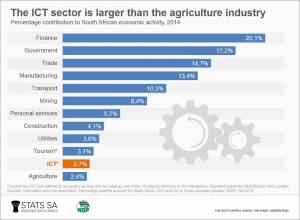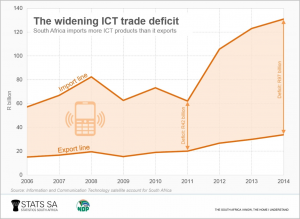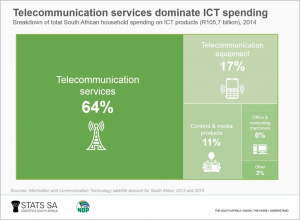
Three facts about the ICT sector
It might be surprising to learn that the ICT sector is larger than the agriculture industry. This is one of the findings from Stats SA’s latest Information and communication technology satellite account for South Africa report. The document covers ICT’s contribution to the gross domestic product (GDP), its role in imports and exports, and its contribution to household spending.
Larger than agriculture, but smaller than tourism
Think of the vast wheat fields of Free State, the wine farms of Western Cape, and the sugarcane fields of KwaZulu-Natal. The South African agriculture industry includes a wide range of activities, from livestock production to horticulture. In 2014, agriculture contributed just over 2,4% to economic production1.
ICT’s contribution, on the other hand, was slightly higher at 2,7%2 (or R93 billion); larger than agriculture, but slightly shy of tourism’s contribution of 3,1%3. In other words, for every R100 that the economy produced in 2014, R2,70 was due to activities related to ICT4.
Breaking it down a little further, just over two-thirds of the R93 billion was a result of activities related to telecommunications services that include, among other things, private broadcasting and cellphone services. The remaining third consisted of computer services (e.g. data processing and software development), manufacturing of ICT equipment (such as electronic components and devices), and activities related to the development of content and media.
ICT imports supersede exports
A country experiences a trade deficit when it imports more than it exports. South Africa has consistently imported more ICT products than it has exported. The trade deficit for ICT has grown since 2011, from R42 billion in 2011 to R97 billion in 2014.
Almost half of ICT imports – 47,5%, in fact – consisted of radio, television and communication equipment, and 30,7% consisted of office and computing machinery. This highlights South Africa’s reliance on other countries to provide it with ICT equipment, such as smartphones, tablets, computers and servers.
South Africa’s largest ICT export – 60,5% of all ICT exports – was broadcasting, telecommunications and information supply services. Think of South Africa’s expansion into the African continent with cellphone services and pay television.
Subscriptions and contracts dominate household ICT budgets
South African households spent in the region of R105,7 billion on ICT in 2014, 4,6% of total household expenditure. Just under two-thirds of the R105,7 billion was spent on telecommunication services, which include contracts and subscriptions. Households spent 17,4% of their total ICT budgets on telecommunications equipment.
For more information on ICT and the economy, download the Information and communication technology satellite account for South Africa, 2013 and 2014 report here.
1 Want to find out more about which industries drive the South African economy? Click here.
2 This is percentage contribution to value added. ICT’s contribution to total GDP was 3,0%.
3 Tourism’s contribution to the economy is covered in more detail here (Tourism Satellite Account for South Africa).
4 ICT and tourism are not industries per se but are referred to as sectors, as they are not listed as one of the 10 main industry divisions in the Standard Industrial Classification (SIC) system. ICT and tourism sectors are compiled with the use of satellite accounts; their activities occur across multiple industries, so their contribution to GDP is calculated by determining (and




